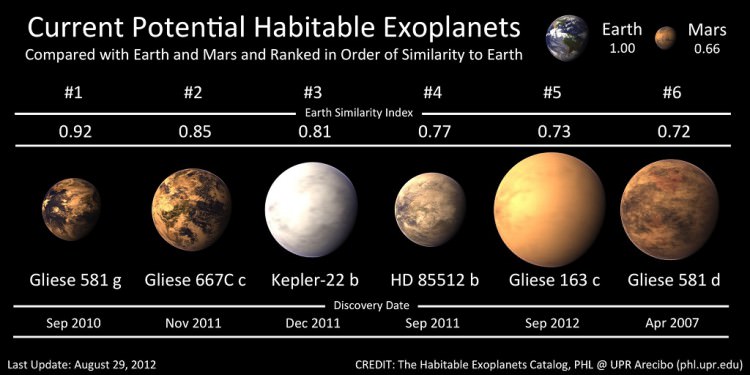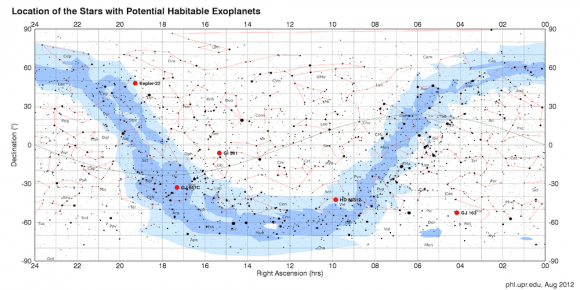Artistic representation of the current five known potential habitable worlds. Will this list broaden under a new habitability model? Credit: The Planetary Habitability Laboratory (PHL)
When we think of life on other planets, we tend to imagine things (microbes, plant life and yes, humanoids) that exist on the surface. But Earth’s biosphere doesn’t stop at the planet’s surface, and neither would life on another world, says a new study that expands the so-called ‘Goldilocks Zone’ to include the possibility of subterranean habitable zones. This new model of habitability could vastly increase where we could expect to find life, as well as potentially increasing the number of habitable exoplanets.
We know that a large fraction of the Earth’s biomass is dwelling down below, and recently microbiologists discovered bacterial life, 1.4 kilometers below the sea floor in the North Atlantic, deeper in the Earth’s crust than ever before. This and other drilling projects have brought up evidence of hearty microbes thriving in deep rock sediments. Some derive energy from chemical reactions in rocks and others feed on organic seepage from life on the surface. But most life requires at least some form of water.
“Life ‘as we know it’ requires liquid water,” said Sean McMahon, a PhD student from the University of Aberdeen’s (Scotland) School of Geosciences. “Traditionally, planets have been considered ‘habitable’ if they are in the ‘Goldilocks zone’. They need to be not too close to their sun but also not too far away for liquid water to persist, rather than boiling or freezing, on the surface. However, we now know that many micro-organisms—perhaps half of all living things on Earth—reside deep in the rocky crust of the planet, not on the surface.”
Location in the night sky of the stars with potential habitable exoplanets (red circles). There are two in Gliese 581. Click the image for larger version. CREDIT: PHL @ UPR Arecibo and Jim Cornmell.
While suns warm planet surfaces, there’ also heat from the planets’ interiors. Crust temperature increases with depth so planets that are too cold for liquid water on the surface may be sufficiently warm underground to support life.
“We have developed a new model to show how ‘Goldilocks zones’ can be calculated for underground water and hence life,” McMahon said. “Our model shows that habitable planets could be much more widespread than previously thought.”
In the past, the Goldilocks zone has really been determined by a circumstellar habitable zone (CHZ), which is a range of distances from a star, and depending on the star’s characteristics, the zone varies. The consensus has been that planets that form from Earth-like materials within a star’s CHZ are able to maintain liquid water on their surfaces.
But McMahon and his professor, John Parnell, also from Aberdeen University who is leading the study now are introducing a new term: subsurface-habitability zone (SSHZ). This denote the range of distances from a star within which planets are habitable at any depth below their surfaces up to a certain maximum, for example, they mentioned a “SSHZ for 2 km depth”, within which planets can support liquid water 2 km or less underground.
If this notion catches on – which it should – it will have exoplanet hunters recalculating the amount of potentially habitable worlds.
The research was presented at the annual British Science Festival in Aberdeen.
Source: University of Aberdeen



I have waited for this. The concept of surface habitability was challenged already by the discovery of icy moons with subsurface oceans.
That they could form a model for this is encouraging. But as for icy moons, it will be difficult to test this which is likely the main reason why little work has been done before. Little or no oxygen atmosphere needs to be a consequence.
It may be somewhat easier though, because nitrogen oxides would be expected to form in cases of early or crustal biospheres and those are likely detectable in higher concentrations.
Though as of yet, in recent work those gases don’t seem to be among found detectable biosignatures (in reflected earthshine from the Moon):
“Low-resolution intensity spectra of Earth’s atmosphere obtained from space reveal strong signatures of life (‘biosignatures’), such as molecular oxygen and methane with abundances far from chemical equilibrium, as well as the presence of a ‘red edge’ (a sharp increase of albedo for wavelengths longer than 700?nm) caused by surface vegetation1. Light passing through the atmosphere is strongly linearly polarized by scattering (from air molecules, aerosols and cloud particles) and by reflection (from oceans and land2). Spectropolarimetric observations of local patches of Earth’s sky light from the ground contain signatures of oxygen, ozone and water, and are used to characterize the properties of clouds and aerosols3, 4.”
Somewhat relatedly, estimates for part of Earth crustal biomass have dropped, the planet may harbor a third less biomass than earlier believed:
“However, it turns out previous estimates of the amount of life in the ocean floor were based on samples taken in very nutrient-rich areas, such as close to shore.”
The main advance is, I think, to extend models of habitable zones, and constraints for abiogenesis, towards more realistic distributions of habitables.
Am i the only one that finds the ‘possibility of exo-planets’ hosting life a very boring topic? I mean, a lot is speculation based on computer models. There isn’t and solid facts and we will never know a definitive answer.
I find it very exciting!
This is what science is, isn’t it? Accumulation of evidence and hypotheses. Every little bit counts.
Isn’t this how our understanding of Evolution became an undisputed fact, except for the finer points? (Please don’t say it’s still just a theory)
(The first exoplanet was discovered only ~twenty years ago, and you find this “boring” already?!)
But evolution is “just a theory”. The problem is, people dont know the difference between Fact, Thesis and Theory. Here in Norway we dont learn the difference until highscool. And since I took mecanics and electronics I didnt learn it before i googled Scientific Method. It should be printet on the first page of every STEM-book since first grade.
A little off-toppic there. Couldnt help it 😉
But yes, every little drip of new knowledge of exoplanets are indeed interesting.
Actually, the extremity of those planets have long since surpassed the world of sci-fi.
My favourite until now are the one orbiting a pulsar. That must be the most amazing place to have a colony, bar the radiation 😉
So I think I will now make a prediction. A thesis: Out there somwhere in the galaxy there should be a rougue planet with a geological activity enough to sustain a comfortable surface temperature and magnetic field. And it will have life. Most likely largeleafed black plants. Animals with IRvision and sonar 🙂
Yes, exoplanets kinda makes my fantasy go wild 😉
Gravity is also only “just a theory”. Do you also deny gravity?
You didnt see those “” I put there. or read my text. I dont deny any theory. Least of them evolution. I am very much a proud atheist thank you. 🙂
I would like to qoute Richard Dawkins. “I chalenge anyone who doupts the theory of gravity to jump of a cliff” 🙂 priceless.
( I think I got that quote right)
Well the “” is what creationists would use. 😉
That is why I made the mistake 🙂
The reason this area is hot is that the scientists involved project that we *will* have an answer to the frequency of inhabited planets within a few decades.
Atmospheric biosignatures are detectable and in many cases unambiguous for habitable terrestrials. By exclusion we can push the frequency of inhabited worlds towards a very low value if that will be the observation, or observe a higher frequency by finding inhabited planets elsewhere as the expectation is.
That other planets have a possibility of hosting life is generally accepted, based on the fact that we observe that it evolved here. The question then becomes one of constraining the likelihood.
Conversely, observing constraints on biospheres such as orbital chaos, mass, atmosphere and yes, modeled, composition of terrestrials will help constrain abiogenesis pathways.
For example, our planet is siliceous instead of carbonaceous. How does that affect abiogenesis and the evolved biosphere? Little organics could stifle abiogenesis, yet it happened easily enough here. On the other hand it is believed that the presence of biotically derived organics held back atmosphere oxygenation for a long time, delaying the rise of complex multicellulars.
Maybe the constraint is such that carbonaceous terrestrials have life but no complex life. And we can test that by observation, siliceous and carbonaceous planets differ in density I believe.
A little bit OT, but the idea of “computer models” differing in spirit from analytically solvable models is non-factual. Good models are testable, irregardless of kind, so no speculation but part of theory.
The measure of models is the same as the measure of other theory, how imprecise is the prediction, how uncertain is the test and how robust (parsimonious, well connected with other theory) is it? Computer models can often be made more precise than analytical models by avoiding simplification, increasing precision and often robustness (avoiding additional constraints put by simplification, balanced by retaining complexity).
Then again there are computer methods that have no analytical correspondence, such as Monte Carlo methods. Even so, they should be judged by their results instead of prejudice.
Yes.